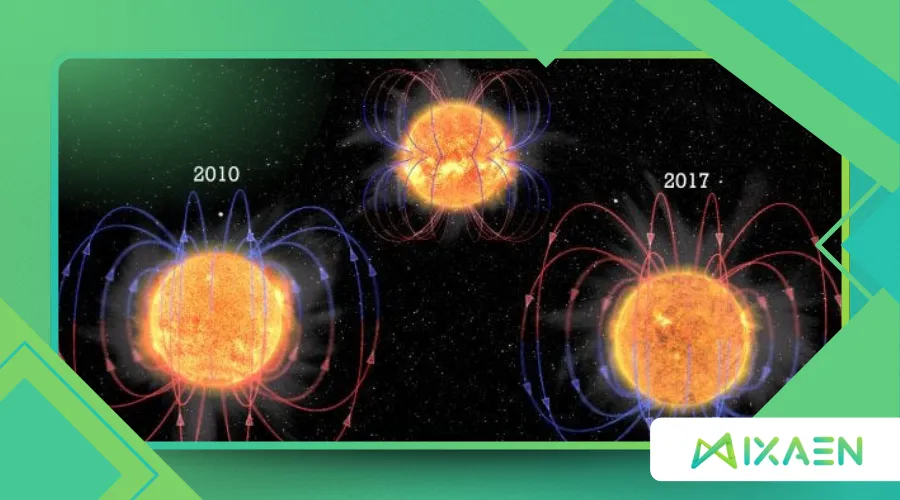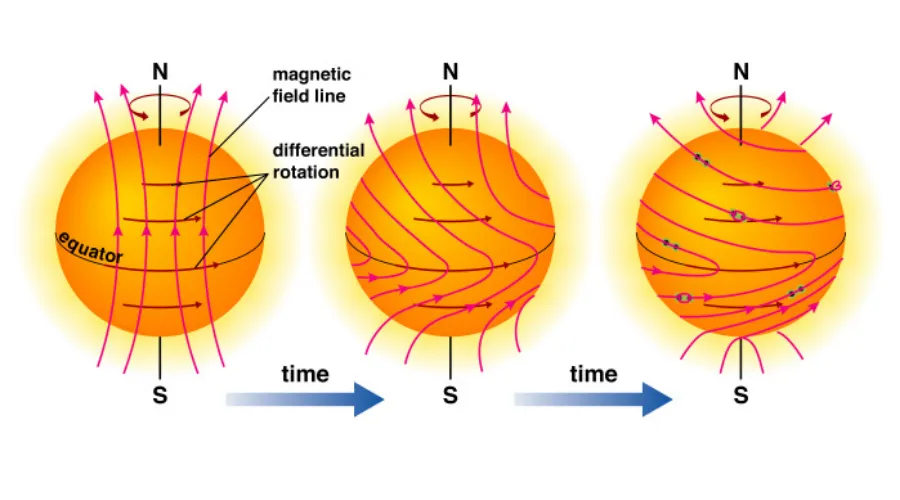Understanding Solar Polar Reversals and Magnetic Field Flips

Magnetic field flips in the Sun’s dynamic atmosphere spark fascination, revealing the intricate dance of cosmic forces shaping our star’s behavior.
Anúncios
Every 11 years, the Sun undergoes a remarkable transformation, reversing its magnetic poles in a process that captivates astronomers and impacts space weather.
This phenomenon, known as solar polar reversal, is more than a celestial curiosity—it’s a window into the Sun’s inner workings and its influence on our planet.
In this exploration, we’ll unravel the science behind these magnetic shifts, their implications for Earth, and why they matter in today’s interconnected world.
What drives these flips, and how do they ripple through the solar system?
Understanding solar polar reversals is crucial not only for astronomers but for anyone interested in the effects of solar activity on technology and the environment.
The Sun’s Magnetic Dynamo: A Cosmic Engine
At the heart of magnetic field flips lies the Sun’s dynamo, a process where swirling plasma generates powerful magnetic fields.
Deep within the Sun, convective currents and rotational forces twist and amplify magnetic lines, creating a complex web of energy.
Picture a cosmic knitting machine, weaving threads of magnetism that stretch from the Sun’s core to its surface.
Unlike Earth’s relatively stable magnetic field, the Sun’s is chaotic, driven by its fluid nature and differential rotation—where the equator spins faster than the poles.
This dynamo powers the solar cycle, an approximately 11-year rhythm marked by rising and falling sunspot activity.
Sunspots, dark patches on the Sun’s surface, are regions of intense magnetic activity.
As the cycle progresses, these spots multiply, peak, and then fade, culminating in a magnetic field flip.
According to NASA’s Solar Dynamics Observatory, the Sun’s magnetic field reverses every cycle, with the most recent flip observed in late 2023 during Solar Cycle 25.
This statistic underscores the predictability of these events, yet their complexity continues to challenge scientists.
Understanding the dynamo process is essential for predicting solar activity, which can have significant effects on technology and communication on Earth.
How Magnetic Field Flips Unfold
Imagine the Sun as a giant bar magnet with a north and south pole.
Over the solar cycle, magnetic field lines become tangled as sunspots migrate toward the poles.
This migration, driven by subsurface flows called meridional currents, carries magnetic flux upward, gradually eroding the existing polar field.
By the cycle’s peak, the poles weaken to near-zero strength, setting the stage for a magnetic field flip.
The poles then reemerge with reversed polarity—north becomes south, and vice versa.
To illustrate, consider a hypothetical star system, “Astraea,” where a star’s magnetic field flips every seven years.
Astronomers on a nearby planet notice increased auroras during these reversals, signaling stronger space weather.
Similarly, on Earth, our observations of solar flips reveal patterns that help predict solar storms.
Unlike Astraea’s fictional star, our Sun’s flips are irregular, sometimes taking months to complete, adding intrigue to their study.
| Phase of Solar Cycle | Magnetic Field Behavior | Key Observations |
|---|---|---|
| Solar Minimum | Stable polar fields, few sunspots | Weak solar activity, calm space weather |
| Solar Maximum | Magnetic field flips, high sunspot activity | Increased solar flares, coronal mass ejections |
The unfolding of these magnetic flips is a complex process, highlighting the dynamic nature of the Sun and its magnetic field.
+ Solar Prominences: Loops of Plasma and Magnetic Energy
Why Magnetic Field Flips Matter
The consequences of magnetic field flips extend far beyond the Sun’s surface.
When the Sun’s magnetic field reverses, it reshapes the heliosphere, the vast bubble of charged particles enveloping the solar system.
This restructuring can amplify space weather events, such as solar flares and coronal mass ejections (CMEs).
These bursts of energy can disrupt satellite communications, GPS systems, and power grids on Earth.
For instance, a powerful CME in 1989 caused a widespread blackout in Quebec, Canada, highlighting the stakes of solar activity.
Why should we care about these distant cosmic shifts?
In our tech-driven world, a single solar storm could cost billions in damages, affecting everything from internet connectivity to airline navigation.
By understanding magnetic field flips, scientists can better forecast space weather, protecting our infrastructure.
This urgency drives research at institutions like the National Solar Observatory, where advanced telescopes track polar field changes in real time.
The implications of solar activity extend to various sectors, emphasizing the need for continuous monitoring and research.

The Science of Tracking Reversals
Observing magnetic field flips requires sophisticated tools.
Magnetographs, instruments that map the Sun’s magnetic field, reveal how polar fields evolve.
Data from the European Space Agency’s Solar Orbiter, launched in 2020, has provided unprecedented views of the Sun’s poles, shedding light on their role in reversals.
These observations show that flips are not instantaneous but gradual, often spanning several months as magnetic fields reorganize.
Consider a second example: a research team studying a star cluster, “Luminos,” notices that stars with faster rotations experience more frequent magnetic flips.
This mirrors our Sun’s behavior, where rotation speed influences magnetic activity.
By comparing such cosmic analogs, astronomers refine models of the Sun’s dynamo, improving predictions of when the next magnetic field flip will occur.
| Tool/Observatory | Purpose | Contribution to Flip Studies |
|---|---|---|
| Solar Dynamics Observatory | Monitors solar magnetic fields | Tracks sunspot migration, polar field changes |
| Solar Orbiter | Observes Sun’s polar regions | Provides high-resolution polar data |
The advancements in tracking technologies are crucial for understanding the dynamics of solar magnetic field flips.
++ The End of the Sun: When and How Our Star Will Die, According to Science
Impacts on Earth and Beyond
The ripple effects of magnetic field flips reach Earth in tangible ways.
During a flip, the heliosphere becomes more permeable to cosmic rays—high-energy particles from distant stars and galaxies.
These rays can penetrate Earth’s atmosphere, potentially affecting climate patterns or astronaut safety during space missions.
A 2023 study in Nature Astronomy found that cosmic ray flux increases by up to 20% during solar maximum, correlating with magnetic field flips.
This statistic highlights the need for robust space weather forecasting.
Beyond Earth, these flips influence the broader solar system.
Planets like Jupiter and Saturn, with their own magnetic fields, interact with the Sun’s altered heliosphere, potentially affecting their auroras.
The Voyager probes, now in interstellar space, have detected changes in the heliosphere’s boundaries tied to past solar cycles, underscoring the far-reaching impact of these events.
The study of these impacts is essential for understanding not only our planet’s safety but also the behavior of other celestial bodies.

Challenges in Predicting Flips
Despite advances, predicting the exact timing of magnetic field flips remains elusive.
The Sun’s chaotic nature defies simple models, and variations between cycles add uncertainty.
For instance, Solar Cycle 24’s flip in 2013 was unusually prolonged, puzzling researchers.
Current models rely on machine learning to analyze magnetic field data, but gaps in polar observations limit accuracy.
The Solar Orbiter’s polar data is closing this gap, offering hope for more precise forecasts.
This unpredictability is like trying to predict the path of a river during a storm—while we can map its general course, sudden shifts catch us off guard.
Addressing these challenges requires global collaboration, combining ground-based observatories with space missions to build a comprehensive picture of solar behavior.
The complexities of solar dynamics necessitate ongoing research and collaboration among scientists worldwide.
Engaging the Future: Why Study Magnetic Field Flips?
What if a single solar event could reshape our technological landscape overnight?
This question drives astronomers to study magnetic field flips with urgency.
These reversals are not just scientific puzzles but critical pieces in safeguarding our digital age.
By decoding the Sun’s magnetic rhythms, we gain insights into stellar evolution, space exploration, and even the habitability of exoplanets.
Stars with frequent magnetic flips may host planets with volatile atmospheres, challenging the search for life.
The pursuit of knowledge about magnetic field flips also inspires innovation.
New telescopes, AI-driven models, and international missions are pushing the boundaries of solar science.
As we approach the peak of Solar Cycle 25, expected around mid-2025, the global astronomy community is poised to capture the next flip in unprecedented detail, promising discoveries that could redefine our understanding of the Sun.
The study of these flips not only advances our scientific knowledge but also prepares us for potential future challenges related to solar activity.
For a deeper dive into the implications of solar activity, you can visit NASA’s Solar Dynamics Observatory.
Conclusion: A Cosmic Dance with Earthly Stakes
Magnetic field flips are a testament to the Sun’s restless energy, a cosmic ballet that shapes our solar system and challenges our scientific ingenuity.
From the dynamo’s churn to the heliosphere’s reach, these reversals reveal the Sun’s profound influence on Earth and beyond.
As technology advances, so does our ability to study and predict these events, protecting our planet from their impacts.
The next time you see an aurora or hear of a solar storm, remember: the Sun’s magnetic field flip is more than a distant phenomenon—it’s a reminder of our star’s power and our need to understand it.
By continuing to explore these cosmic processes, we not only enhance our understanding of the universe but also safeguard our technological future.
